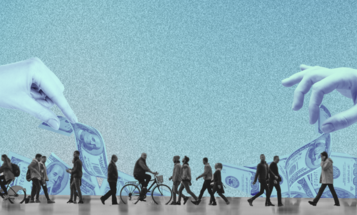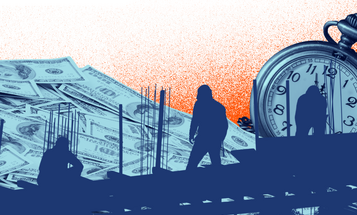
Worker-Driven Social Responsibility: A Model That Builds Power for Workers on the Margins
Amid ongoing attacks on worker protections and enforcement, worker-driven social responsibility programs offer alternative, scalable pathways to building collective power for workers across industries.

Introduction
All workers deserve to earn a thriving wage, to work in a safe and healthy workplace, and to be treated with respect and dignity on the job. But weak labor laws, underfunded government oversight agencies, stagnant wages, and increased corporate power have made it increasingly difficult for many workers to get a fair shot in our economy, much less get ahead. Black and brown workers, Hispanic workers, and immigrant workers have been feeling these problems first and worst.
Few industries show the stakes—and the potential for transformative change—like agriculture.
Farmworkers are among the most vulnerable workers in the country, and it is by design that they lack basic workplace protections.
Farmworkers are among the most vulnerable workers in the country, and it is by design that they lack basic workplace protections. The history of racist exclusions from New Deal-era legislation has been well documented. Congress explicitly excluded agricultural workers from labor and employment laws at the time because of the high concentration of Black workers in the sector. The concentration of Black workers itself was a direct legacy of the forced labor of enslaved Black people in Southern agriculture before the Civil War. This is a sector that has always and continues to be dependent on workers of color. As of 2022, 73 percent of farmworkers are Hispanic, and 66 percent are noncitizen immigrants.
Despite—or maybe because of—the structural and systemic challenges they face, agricultural workers have developed an innovative and highly successful model for building collective worker power in their industry: worker-driven social responsibility (WSR). The WSR model can provide both inspiration and strategic insight for building collective power for all workers, even across other industries.
What Is Worker-Driven Social Responsibility?
In the United States, unions have long been seen as the first and best way to build worker power. But as unionization rates have declined to record lows, workers and organizers have looked for strategies that complement traditional power-building methods, particularly for workers who lack the legal right to unionize. One of these promising strategies is WSR.
The core components of the WSR model include the following:
Worker-Driven Models: To effectively build power, a program for protecting workers must be driven by those who are most affected—the workers themselves. Workers must lead the creation, monitoring, and enforcement of programs intended to improve their working conditions in corporate supply chains where it has been difficult or impossible for workers to unionize.
Legally Binding Agreements: WSR programs are built on binding agreements directly between worker organizations and the brands and retailers at the tops of supply chains, creating the necessary incentives for workers’ direct employers to improve working conditions. These agreements create enforceable market consequences for companies in their supply chains. Large buyers must (a) buy first from suppliers that maintain good standing with a WSR program and (b) shift purchases away from suppliers that cannot comply with a WSR program’s protections for workers.
Monitoring and Enforcement: The design of know-your-rights education, compliance monitoring, and program enforcement must provide workers with a powerful and effective voice in the protection of their own rights. Workers must drive the creation of standards for a uniform code of conduct for their industry, and program compliance requires independent verification with those standards by an auditor selected by the worker organization (as opposed to a corporate-selected monitor).
One of the first and most noteworthy examples is the Fair Food Program (FFP), which exists in the private sector and is the result of privately negotiated and binding legal agreements between a farm worker organization and large food retail companies (as opposed to the growers or farm labor contractors that directly employ farmworkers). The agreements obligate large food buyers, such as McDonald’s, Whole Foods, and Walmart, to buy first from growers that are in compliance with an independent monitoring program created by a farmworker organization and move purchases away from noncompliant growers.
The Fair Food Program’s standards are largely based on existing state and federal protections for farmworkers, though these laws are frequently underenforced outside of the FFP, and the FFP provides additional protections in areas where those laws are lacking, such as heat protections. If a grower falls out of compliance with the standards of the program, the buyers at the top of the supply chain must shift their purchases to other growers that are continuing to treat their workers in accordance with the law and the Fair Food Program’s standards.
The FFP has transformed the Florida tomato industry, once dubbed “ground zero for modern-day slavery,” into the “best workplace environment in U.S. agriculture.”
Economic incentives and consequences, combined with a rigorous worker education and monitoring program, have proven exceptionally successful in securing workers’ rights on the ground. The FFP has transformed the Florida tomato industry, once dubbed “ground zero for modern-day slavery,” into the “best workplace environment in U.S. agriculture.” The workers on FFP farms have “one of the most well-reported and effective grievance and remedy systems” against forced labor, physical violence, sexual harassment, or heat stress in the industry. Wage theft and verbal abuse are exceedingly rare and, when uncovered, swiftly investigated and resolved. Wages have “increased by 60 to 100 percent,” and even the farm owners have “benefited from a more stable workforce and improvements in safety and productivity.”
While the FFP covers 20,000 farmworkers, more than some unions in other industries, this is still a small portion of the more than 2.6 million agricultural workers in the country. For the many workers outside the FFP, dangerous working conditions, low wages, wage theft, and even forced labor are still serious risks.
What’s Next for Worker-Driven Social Responsibility?
Other worker organizations have taken note of the FFP’s success and the unique power of the WSR model, and groups have launched their own WSR programs in various industries and across international boundaries: dairy, construction, fishing, apparel, garments, and textiles.
For example, an organization of plant nursery workers in South Florida, WeCount!, has begun building its own worker-driven program, closely modeled after the FFP, called “Planting Justice.” The houseplant industry is a subsector of agriculture with many parallels to the tomato industry: Large corporate retailers with immense purchasing power sit at the top of the supply chain; vulnerable Black, brown, and immigrant workers make up a majority of the workforce; those workers experience shocking working conditions, including “poverty wages, lack of benefits, sexual harassment and violence, dangerous exposure to pesticides, and lack of protections from extreme heat;” and now those workers have begun to organize for a WSR program to correct the power imbalance in their industry. Dēmos and WeCount! will soon release an in-depth report on plant nursery workers and the potential for the WSR model to transform the industry.
Conclusion
With government worker protections and enforcement agencies under attack and agricultural workers facing unsafe and exploitative working conditions, the case for the WSR model has only become more compelling. In the absence of stronger legal protections, agricultural workers have developed innovative and adaptable ways to establish and enforce their rights, offering alternative and scalable paths to worker justice for workers across the economy.




